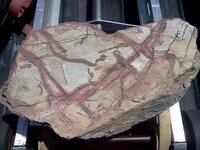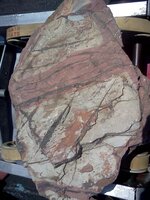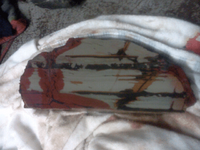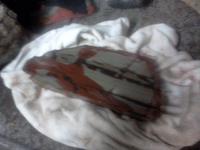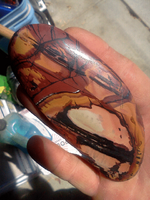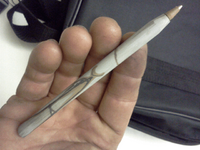Navigation
Install the app
How to install the app on iOS
Follow along with the video below to see how to install our site as a web app on your home screen.
Note: This feature may not be available in some browsers.
More options
You are using an out of date browser. It may not display this or other websites correctly.
You should upgrade or use an alternative browser.
You should upgrade or use an alternative browser.
indian paint rock so happy
- Thread starter rockhoundrich
- Start date
rockhoundrich
Full Member
- Thread starter
- #3
Indian paint rock is a sedementary rock. it is a sandstone found in Nevada and California. The interesting paterns and colors are created by trace amounts of iron and manganese being drawn into the rock by capilary action through minute cracks in the stone
Upvote
0
rockhoundrich
Full Member
- Thread starter
- #4
I can maybe see ryolite based on the pictures but chalcedony not a chance also it has a mohs of 3-3.5 which takes ryolite out also I know when where and by who it was collected
Upvote
0
Eu_citzen
Gold Member
- Sep 19, 2006
- 6,484
- 2,111
- Detector(s) used
- White's V3, Minelab Explorer II & XP Deus.
- Primary Interest:
- Prospecting
Thanks, was not familiar with that term.
Yes, was just going by first impressions. Is that the weathered surface, or a freshly exposed surface we see?
A hardness of 3 - 3.5 also takes out sandstone.
Weathered "halleflint" can also resemble it.
But the hardness ruled out all above.
Yes, was just going by first impressions. Is that the weathered surface, or a freshly exposed surface we see?
A hardness of 3 - 3.5 also takes out sandstone.
Weathered "halleflint" can also resemble it.
But the hardness ruled out all above.
Upvote
0
rockhoundrich
Full Member
- Thread starter
- #6
ok after talking with a couple geologist friends they say it is concidered a type of jasper but the grains are so loose it has the aperance of having a lower mohs the light color is a sandstone sedimentary where the black is manganise red is iron there is varying hardness depending on where its scratched ive been working this type of stone for several years and have some smaller chunks left over from some of my sculpting the person that collected it got it from death valley ca back in the 70s but in 1992 the area was closed to collecting also ive heard that the area was almost completely hunted out some other deposits have been found but are few and far between and closely guarded due to its high price ive seen it selling on ebay for as much as $40 per pound for the higher quality material the term indian paint rock is a common name due to the color paterns not the actual name due to the many minerals that make up its composition
Upvote
0
Bajahunter
Sr. Member
- Mar 26, 2011
- 265
- 107
The softer material could be ocher.
Ochre - Wikipedia, the free encyclopedia
I have found similar material down here but yellower and much smaller veins.
Ochre - Wikipedia, the free encyclopedia
I have found similar material down here but yellower and much smaller veins.
Upvote
0
Eu_citzen
Gold Member
- Sep 19, 2006
- 6,484
- 2,111
- Detector(s) used
- White's V3, Minelab Explorer II & XP Deus.
- Primary Interest:
- Prospecting
Jasper does not have any grains. Sandstone does.
Now, if they fall off when doing a hardness test I can see one can mistake it for having a lower hardness then it actually does.
Now, if they fall off when doing a hardness test I can see one can mistake it for having a lower hardness then it actually does.
Upvote
0
ScribbleMuse
Jr. Member
- Jul 12, 2012
- 44
- 25
- Detector(s) used
- Bounty Hunter - Lone Star
- Primary Interest:
- All Treasure Hunting
That looks really pretty inside! Can't wait to see what you do with it. 

Upvote
0
rocksnsilver
Greenie
- Jun 18, 2012
- 10
- 2
- Detector(s) used
- Troy Shadow X2
- Primary Interest:
- All Treasure Hunting
Very nice cab! Love Indian Paint Rock!
Upvote
0
Sklybones
Jr. Member
- Nov 16, 2009
- 27
- 3
- Detector(s) used
- Whites Spectrum xlt Minelab Xt 18000
- Primary Interest:
- All Treasure Hunting
Thats some cool rock, And I know Iv'e walked over it a time or two and may even have some here at the house, Never thought to cut it, It didn't look like it would take a polish..Showed youre pics to my brother and we both agreed on where we had seen it, so we will be going to get some and see how it turns out...Thanks for your post and showing us what we've been overlooking
Upvote
0
Bajahunter
Sr. Member
- Mar 26, 2011
- 265
- 107
I am really amazed at this rock. Because of the colors in the rock, but also that is appears fairly easy to work. All your work has been both beautiful and unique.
How hard is it?
I have also seen rock similar to yours down here in Baja. Not sure if it is the same. But I plan on picking some up the next time I come across it and polishing it up.
How hard is it?
I have also seen rock similar to yours down here in Baja. Not sure if it is the same. But I plan on picking some up the next time I come across it and polishing it up.
Upvote
0
rockhoundrich
Full Member
- Thread starter
- #19
Thanks for the compliment the hardness varies the grey/white areas are around a 3 the red is near 4 and the black is 5.5-6 making it a little difficult to work unless using diamond grinding wheels sometimes I prefer to work stone by hand but with the hardness variation it creates almost a 3D effect
Upvote
0
Top Member Reactions
-
 3448
3448 -
 1965
1965 -
 1908
1908 -
 1148
1148 -
 1089
1089 -
 1006
1006 -
 876
876 -
 861
861 -
 860
860 -
 776
776 -
 757
757 -
 676
676 -
 653
653 -
 567
567 -
 504
504 -
 451
451 -
 447
447 -
 410
410 -
 403
403 -
E
398
Users who are viewing this thread
Total: 2 (members: 0, guests: 2)
